The project obtained funding from the Heritage Lottery Fund for two seasons of excavations, each lasting three weeks, taking place at Ponthendre motte and bailey and on Longtown Castle Green.
Both sites are Scheduled Monuments so before starting work we had to apply to Historic England for formal consent from the Secretary of State for Culture, Media and Sport. To the best of our knowledge no other community archaeology project has ever excavated at two scheduled monuments simultaneously. To see the maps of the scheduled areas for both sites click on Ponthendre or Longtown.
Our archaeological contractor, Herefordshire Archaeology, headed up by Tim Hoverd, provided us with a first class team of five professional archaeologists who were joined by over 40 volunteers. These were mainly from the Longtown area, but some came from further afield. Kevin and Shannon May, from Alaska, spent a week of their holiday on the dig. For many it was their first experience of excavation but there were several volunteers who had trained as archaeologists and brought their skills with them. All volunteers worked under the direct supervision of the Herefordshire Archaeology professionals and were given training to suit the tasks allotted to them.
provided us with a first class team of five professional archaeologists who were joined by over 40 volunteers. These were mainly from the Longtown area, but some came from further afield. Kevin and Shannon May, from Alaska, spent a week of their holiday on the dig. For many it was their first experience of excavation but there were several volunteers who had trained as archaeologists and brought their skills with them. All volunteers worked under the direct supervision of the Herefordshire Archaeology professionals and were given training to suit the tasks allotted to them.
The excavations at Ponthendre
Peter Dorling was our Senior Project Archaeologist at Ponthendre, supported by Simon Mayes. We opened up three trenches: –
Ponthendre 1
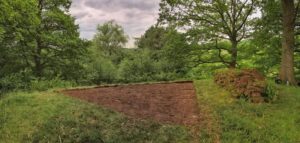 This trench exposed one quarter of the top of the Ponthendre motte. We were hoping to learn about the tower that usually crowns a motte – whether it was round or square and whether it was built of wood or stone. However, we found no evidence for the foundations of a tower, suggesting that either it was removed leaving no trace in the soil or no tower was ever built.
This trench exposed one quarter of the top of the Ponthendre motte. We were hoping to learn about the tower that usually crowns a motte – whether it was round or square and whether it was built of wood or stone. However, we found no evidence for the foundations of a tower, suggesting that either it was removed leaving no trace in the soil or no tower was ever built.
Ponthendre 2
 This trench started at the edge of the bailey and continued down the scarp slope to determine the nature of any fortifications. It provided clear evidence that the bailey was protected by both a rampart and a water-filled moat. A single post-hole with packing stones suggested that the rampart was topped by a palisade.
This trench started at the edge of the bailey and continued down the scarp slope to determine the nature of any fortifications. It provided clear evidence that the bailey was protected by both a rampart and a water-filled moat. A single post-hole with packing stones suggested that the rampart was topped by a palisade.
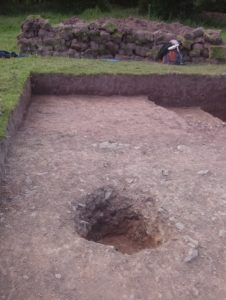 The soil below the rampart showed that the area had formerly been forested. A flint blade, retouched for use as a concave scraper, and two waste flakes of flint demonstrated that stone toolmaking had occurred at Ponthendre during
The soil below the rampart showed that the area had formerly been forested. A flint blade, retouched for use as a concave scraper, and two waste flakes of flint demonstrated that stone toolmaking had occurred at Ponthendre during
prehistoric times.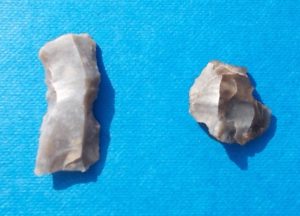
Ponthendre 3
This trench was sited in the bailey with the hope of finding evidence for buildings and activities that may have taken place there. The area excavated produced no sign of any structures – in fact no finds whatsoever.
This strongly suggests that the castle may never have been completed and was abandoned by the builders after they had made a monumental investment in the earthworks. There are several possible explanations including: –
1) Perhaps the Welsh drove the Normans away before they were able to finish the defences. This interpretation would be most plausible if Ponthendre had been a very early castle built during the tenure of the first Hugh de Lacy. As discussed under History results, this seems unlikely.
2) A more likely explanation is that the building of Ponthendre was abandoned after the sudden death of Payne Fitzjohn, who may have started to build the castle in response to Welsh aggression and/or the outbreak of civil war in 1133-34. Payne was killed by the Welsh in 1137, after which the area came under the control of Jocelyn de Dinan, who may have had little interest in Ewyas, his main focus being further north around Ludlow.
We will return to Ponthendre in July. If further excavation confirms that the castle was never completed, we will need to rewrite the accepted history that this was the Castle of Ewyas that preceded and co-existed with Longtown ‘New castle’.
The excavations at Longtown Castle Green
Dr Nigel Baker was our Senior Project Archaeologist for Castle Green, supported by Dale Rouse and Dan Lewis. We opened up two trenches: –
Castle Green 1
This trench exposed a section through the massive rampart that surrounds Longtown Castle and the Green. Traditionally it was believed that the rampart was Roman, but it may have been built during the Iron Age or the late Saxon period. Our objectives were to determine the structure of the rampart and find evidence for when it was built.
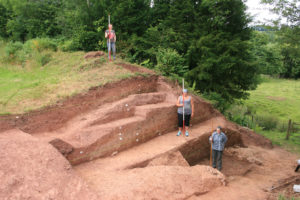 The stepped section was cut into one side of the existing gap on the east side of the rampart. It showed that the rampart was built primarily from turf, earth and then soft stone that had been quarried from the ditch around the rampart. It seems to have been a simple earthwork without any timber or stone facing. We found no evidence for a wall or palisade on the top of the rampart, so it may have been protected by a thorn hedge. There were no finds in the lower levels of the
The stepped section was cut into one side of the existing gap on the east side of the rampart. It showed that the rampart was built primarily from turf, earth and then soft stone that had been quarried from the ditch around the rampart. It seems to have been a simple earthwork without any timber or stone facing. We found no evidence for a wall or palisade on the top of the rampart, so it may have been protected by a thorn hedge. There were no finds in the lower levels of the 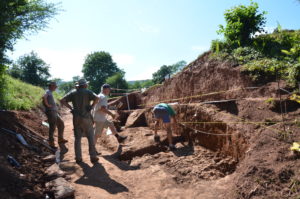 rampart. This showed that when it was built, Longtown was a green field site and it almost certainly precludes the Romans, who usually left rubbish wherever they went. A small amount of charcoal recovered from the lower turf layer may provide us with a radiocarbon date to tell us whether the rampart was of Norman origin or earlier.
rampart. This showed that when it was built, Longtown was a green field site and it almost certainly precludes the Romans, who usually left rubbish wherever they went. A small amount of charcoal recovered from the lower turf layer may provide us with a radiocarbon date to tell us whether the rampart was of Norman origin or earlier.
Castle Green 2
This trench was dug in a bumpy area of the Green where we were looking for evidence of what activities had taken place within the rampart. 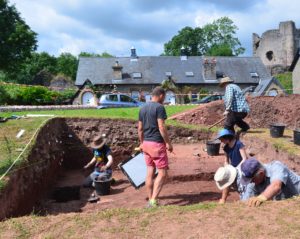
The topsoil contained some small change, pieces of clay tobacco pipe, slate, pencils and sherds of pottery from the 15th to the 20th century. Almost immediately we found two corroded iron arrowheads, one leaf–shaped, the other bodkin style.
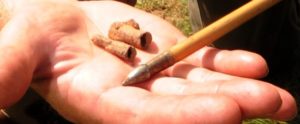 Below the topsoil we uncovered a layer of broken stone containing pieces of roof tiles and sherds of pottery from the 13th to the 17th century. This was probably demolition material from clearing the site for the old school, built in 1869.
Below the topsoil we uncovered a layer of broken stone containing pieces of roof tiles and sherds of pottery from the 13th to the 17th century. This was probably demolition material from clearing the site for the old school, built in 1869.
A small pit, which had been cut into the next layer, contained three sherds of 13th century cooking pot.
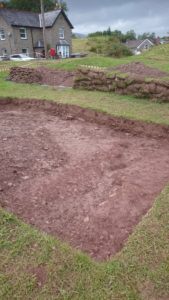
layer with gully cut into marl
Below this, the ground had been levelled with a layer of marl containing animal bones, sherds of late 13th century pottery, iron nails and iron slag. A post-hole lined with packing stones and a gully had been cut into the marl, suggesting the presence of a simple building such as a workshop.
Towards the end of the dig, we uncovered a mediaeval floor made of compacted gravel covered with trampled soil, containing early 13th century black cooking pot and fragments of burnt animal bone. A row of flat stones was perhaps the remains of a wall. Below the level of the floor we found dark soil containing fragments of cooking pot, burnt bone and charred grain, probably indicating a rubbish pit or a cesspit dating to the late 12th century.
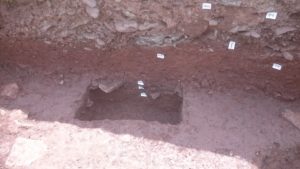
early 13thC floor with cut through to 12th century deposits
These features were found too late to be investigated properly, so we covered them with a tarpaulin before backfilling. In July 2017 we will reopen and extend this trench, knowing that below the tarpaulin we will be already in amongst late 12th and early 13th century archaeology.
This is only a brief overview of the first season of excavations. A digital copy of the interim excavation report is obtainable on request.
